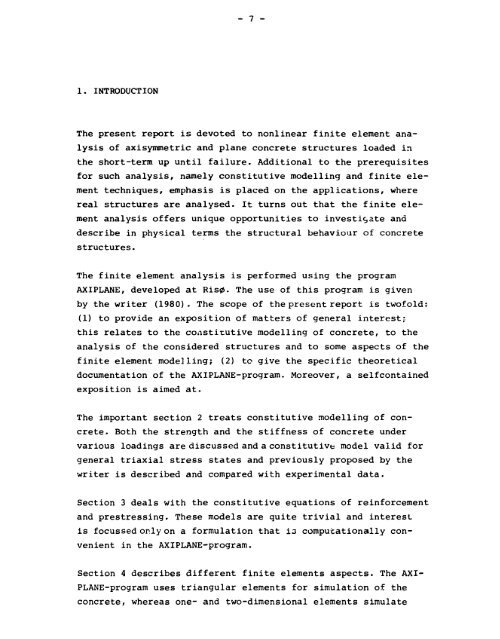Nonlinear Finite Element Analysis of Concrete Structures
Nonlinear Finite Element Analysis of Concrete Structures
Nonlinear Finite Element Analysis of Concrete Structures
You also want an ePaper? Increase the reach of your titles
YUMPU automatically turns print PDFs into web optimized ePapers that Google loves.
- 7 -<br />
1. INTRODUCTION<br />
The present report is devoted to nonlinear finite element analysis<br />
<strong>of</strong> axisymmetric and plane concrete structures loaded in<br />
the short-term up until failure. Additional to the prerequisites<br />
for such analysis, namely constitutive modelling and finite element<br />
techniques, emphasis is placed on the applications, where<br />
real structures are analysed. It turns out that the finite element<br />
analysis <strong>of</strong>fers unique opportunities to investigate and<br />
describe in physical terms the structural behaviour <strong>of</strong> concrete<br />
structures.<br />
The finite element analysis is performed using the program<br />
AXIPLANE, developed at Risø. The use <strong>of</strong> this program is given<br />
by the writer (1980). The scope <strong>of</strong> the present report is tw<strong>of</strong>old:<br />
(1) to provide an exposition <strong>of</strong> matters <strong>of</strong> general interest;<br />
this relates to the constitutive modelling <strong>of</strong> concrete, to the<br />
analysis <strong>of</strong> the considered structures and to some aspects <strong>of</strong> the<br />
finite element modelling; (2) to give the specific theoretical<br />
documentation <strong>of</strong> the AXIPLANE-program. Moreover, a selfcontained<br />
exposition is aimed at.<br />
The important section 2 treats constitutive modelling <strong>of</strong> concrete.<br />
Both the strength and the stiffness <strong>of</strong> concrete under<br />
various loadings are discussed and a constitutive model valid for<br />
general triaxial stress states and previously proposed by the<br />
writer is described and compared with experimental data.<br />
Section 3 deals with the constitutive equations <strong>of</strong> reinforcement<br />
and prestressing. These models are quite trivial and interest<br />
is focussed only on a formulation that is computationally convenient<br />
in the AXIPLANE-program.<br />
Section 4 describes different finite elements aspects. The AXI<br />
PLANE-program uses triangular elements for simulation <strong>of</strong> the<br />
concrete, whereas one- and two-dimensional elements simulate
















